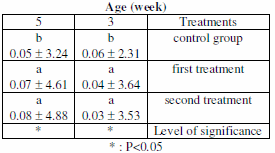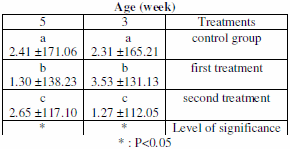Effect of Adding Lycopene to the Ration on Some Blood Serum Biochemical Traits of Broiler Ross 308
This study was conducted at Poultry Farm of Animal Resources Dept., College of Agriculture, University of ALQasim Green to investigate the effect of adding Lycopene to the ration on some blood serum biochemical traits of broiler Ross 308. Use the 90 broiler chicks Ross 308 day-old were randomly assigned to three treatments (by 3 replicates per treatment 10 chicks per replicate), and treatments were as follows: control group without adding lycopene to the diet, add lycopene by 250 mg / kg feed (first treatment) and add lycopene by 500 mg/kg feed (second treatment). The experiment included a study of the following characteristics: concentrations of glucose, protein, cholesterol and triglycerides.
The results indicated that the addition of lycopene by 250 and 500 mg/kg feed to broiler diet led to a significant improvement in blood serum biochemical traits of broiler.
Keywords: lycopene, blood serum biochemical traits, broiler.





References
Agarwal, S. and Rao, A. V. 2000. Tomato lycopene and its role in human health and chronic diseases . C.M.A.J., September 19:163-166 .
Alina, V., W. Dorien. M. Johannes, and D. Jaap van . 2007. Lycopene supplementation elevates circulating
insulin- like growth factor- binding protein- 1 and -2 concentrations in persons at greater risk of colorectal cancer. The American J.Clin.Nut.17:10-16 .
Amany,M., M. Ahmed, A.Gaafar and M.Shaker Arafat.2009. Tomato lycopene is a natural antioxidant and can alleviate hypercholes-terolemia. African J.Biotechno.8(23):6627- 6633 .
Asatoor, A. M. and E. J. King. 1954. Simplified colorimetric blood sugar method. Biochem. J. 56:44- 46.
Barbara,L., A . K. Dillingham and A. V. Rao.2009. Biologically Active lycopene in human health . Int. JNM.,4(1):23-26 .
Blum, A., Monir, M., Wirsansky, I., and Ben-Arzi, S.2006.. The beneficial effects of tomatoes. Eur. J. Intern. Med 16.402-404 .
Borel P., Moussa M., Reboul E., Lyan B., Defoort C.,Vincent-Baudry S., Maillot M., Gastaldi M., Darmon M., Portugal H., Planells R. and Lairon D. 2007.Human plasma levels of vitamin E and carotenoids are associated genetics polymorphisms in genes involved in lipid metabolism. J. of Nutrition. 137, 2653– 2659 .
Botsoglou,N., G. Papageorgiou and I. Nikolakakis.2004. Effect of dietary dried tomato pulp on oxidative stability of Japanese quail meat. J.Agric. Food Chem,52: 2982-2988 .
Duncan , B.D .(1955) . Multiplerange and multiple f-test Biometrics , 11:1-42.
Englmaierová,M., Bubancová,I., T. Vít.,and Skrivan,M. 2011.The effect of lycopene and vitamin E on growth performance, quality and oxidative stability of chicken leg meat.Czech J. Anim. Sci., 56 (12): 536– 543.
Franey, R. J. and A. Elias. 1968. Serum cholesterol measurement based on ethanol extraction and ferric chloridesulfuric acid. Clin. Chem . Acta 2: 255-263 .
Henry, R. J., D. C. Cannon and J. W. Winkelman. 1974. Clinical Chemistry, Principles and Techniques . 2nd Ed. Harper & Row.
Laker, M., F. 1996 . Clinical Biochemistry for Medical Students .W. B. Saunders Company , Ltd. PP .345-349 .
Murray,R. K., D. K. Granner, P. A. Mayes and V. W. Rodwell. 2003. Harper’s I11ustrated Biochemistry. Medical Book . 26th ed. Mc Graw-Hill Company In.,USA.
National Research Council (NRC) . 1994. Nutrient requirement of poultry then. National Academy press. Washington. D. C. USA.
Rao, A.V. and H. Shen.2002 . Effect of low dose of lycopene in take on lycopene bioavailability and oxidize stress . Nutr. Res,22:1125-1131 .
Rao, A. V. and Rao, L. G. 2004. Lycopene and human health. Nutraceut. Res. 2:127–136.
Sahin K., Onderci M.C., Sahin N., Gursu M.F. and Kucuk O.2006a.Effects of lycopene supplementation on antioxidant status, oxidative stress, performance and carcass characteristics in heat-stressed Japanese quail. J. of Thermal Biology, 31, 307–312.
Sahin,N., Sahin, K., Onderci M.C., Karatepe, M.,Smith,M,O. and Kucuk O. 2006b.Effects of dietary lycopene and vitamin E on egg production , antioxidant status,and cholesterol level in Japanese quail. Asian – Australasian J. of Ani. Sci., 19 : 224 – 230 .
SAS, 2010. SAS/ STAT Users Guide for Personal Computers Release 9.1 SAS . Institute Inc. Cary and N.C USA.
Ševcíková S., Skrivan M. and Dlouhá G. 2008. The effect of lycopene supplementation on lipid profile and meat quality of broiler chickens. Czech J. of Animal Sci. 53, 431–440.
Shi, J. and Maguer, L. 2000. Lycopene in tomatoes: chemical and physical properties affected by food processing. Crt. Rev. Food Sci. Nutr. 40:1–42.
Squires,E. J. 2003. Applied Animal Endocinology. CAB Inter-national. Wallingford. Oxon O X10 8DE. UK. 83- 85 .
Sridevi, A.2008 . A dose-response study on the effects of purified lycopene supplementation on biomarkers of oxidative strees. J Am Col.Nutr,27: 267-273 .
Sturkie, P. D. 2000. Avian Physiology. 5th ed. New York, Heidelberg, Barlin, Springer Verlag.
Toro,G and P. G. Ackermann.1975.Practical clinical chemistry little Brown Company.Boston .pp.354
Wu, A., Andriotis, V., Durrant, M. and Rathjen, J. 2004. A patch of surface-exposed residues mediates negative regulation of immune signaling by tomato. Pto. Plant Cell.16: 2809–2821.








.jpg&w=3840&q=75)